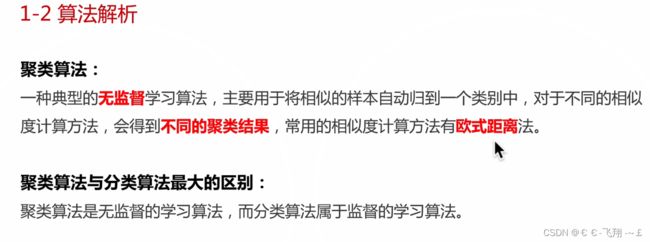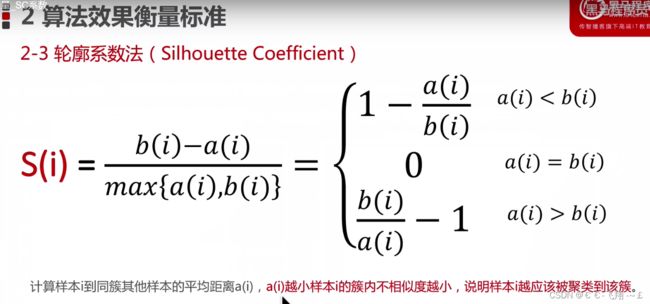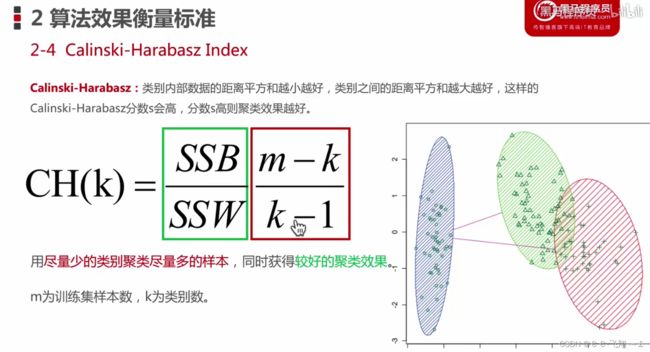机器学习 聚类算法总结
目录
一、聚类算法简述
二、K-Means算法实现案例一——简单实现
三、K-Means算法实现案例二——案例实现
四、K-Means算法实现案例三
五、 轮廓系数
六、CH系数
七、聚类实现图像压缩
八、肘步法
一、聚类算法简述
二、K-Means算法实现案例一——简单实现
# 一、导入库
import numpy as np
import matplotlib.pyplot as plt
from sklearn.cluster import MiniBatchKMeans, KMeans
from sklearn import metrics
from sklearn.datasets._samples_generator import make_blobs
def handler():
# 二、生成数据集
x, y = make_blobs(n_samples=1000, n_features=2, centers=[[-1, -1], [0, 0], [1, 1], [2, 2]],
cluster_std=[0.4, 0.2, 0.2, 0.2], random_state=9)
# 生成数据散点图
plt.scatter(x[:, 0], x[:, 1], marker="o")
plt.show()
# 三、可视化
for index, k in enumerate((2, 3, 4, 5)):
plt.subplot(2, 2, index + 1)
y_pred = MiniBatchKMeans(n_clusters=k, batch_size=200, random_state=9).fit_predict(x)
score = metrics.calinski_harabasz_score(x, y_pred)
plt.scatter(x[:, 0], x[:, 1], c=y_pred)
plt.text(.99, .01, ("k=%d,score:%.2f" % (k, score)),
transform=plt.gca().transAxes, size=10,
horizontalalignment='right')
# 显示图像
plt.show()
if __name__ == '__main__':
handler()
三、K-Means算法实现案例二——案例实现
# 一、导入库
import pandas as pd
import matplotlib.pyplot as plt
import seaborn as sns
import numpy as np
import numpy.random as nr
import math
def handler():
# 二、观察数据集
auto_prices = pd.read_csv("Automobile price data _Raw.csv")
# 三、重新编码名称
auto_prices.colums = [str.replace('-', "_") for str in auto_prices.columns]
# 四、处理缺失值
for col in auto_prices.columns:
if auto_prices[col].dtype == object:
count = 0
count = [count + 1 for x in auto_prices[col] if x == "?"]
print(col + "" + str(sum(count)))
auto_prices.drop("normalized_losses", axis=1, inplace=True)
cols = ["price", "bore", 'stroke', "horsepower", "peak_rpm"]
for column in cols:
auto_prices.loc[auto_prices[column] == "?", column] = np.nan
auto_prices.dropna(axis=0, inplace=True)
# 五、转换列数据类型
for column in cols:
auto_prices[column] = pd.to_numeric(auto_prices[column])
# 六、特征工程
cylinder_categories = {"three": "three_four", "four": 'three_four',
"five": "five_six", "six": "five_six",
"eight": "eight_twelve", "twelve": "eight_twelve"}
auto_prices['num_of_cylinders'] = [cylinder_categories[x] for x auto_prices['num_of_cylinders']]
# 七、箱线图
def plot_box(auto_price, col, col_y="price"):
sns.set_style("whitegrid")
sns.boxplot(col, col_y, data=auto_price)
plt.xlabel(col)
plt.ylabel(col_y)
plt.show()
plot_box(auto_prices, "num_of_cylinders")
if __name__ == '__main__':
handler()
四、K-Means算法实现案例三
# 一、导入库
import numpy as np
from sklearn.cluster import KMeans
from scipy.spatial.distance import cdist
import matplotlib.pyplot as plt
def handler():
# 二、生成K值并可视化
cluster1 = np.random.uniform(0.5, 1.5, (2, 10))
cluster2 = np.random.uniform(3.5, 4.5, (2, 10))
X = np.hstack((cluster1, cluster2)).T
# 遍历k值并可视化
K = range(1, 10)
meandistortions = []
for k in K:
# 运用KMeans算法
kmeans = KMeans(n_clusters=k)
kmeans.fit(X)
meandistortions.append(sum(np.min(cdist(X, kmeans.cluster_centers_, "euclidean"), axis=1)) / X.shape[0])
plt.plot(k, meandistortions, 'bx-')
plt.xlabel("k")
# 设置平均畸变程度
plt.ylabel("Ave Distor")
# 增加表头
plt.show()
if __name__ == '__main__':
handler()
五、 轮廓系数
六、CH系数
七、聚类实现图像压缩
# 一、导入库
import numpy as np
import matplotlib.pyplot as plt
from sklearn.cluster import KMeans
from sklearn.metrics import pairwise_distances_argmin
from sklearn.datasets import load_sample_image
from sklearn.utils import shuffle
def handler():
# 二、导入图片,设定参数
n_colors = 64
ball = load_sample_image("ball.jpg")
ball = np.array(ball, dtype=np.float64) / 255
w, h, d = original_shape = tuple(ball.shape)
assert d == 3
image_array = np.reshape(ball, (w * h, d))
image_array_sample = shuffle(image_array, random_state=0)[:1000]
kmeans = KMeans(n_clusters=n_colors, random_state=0).fit(image_array_sample)
labels = kmeans.predict(image_array)
# 四、可视化
plt.figure(1)
plt.clf()
ax = plt.axes([0, 0, 1, 1])
plt.axes("off")
plt.title("Original image(96, 615 colors)")
plt.imshow(ball)
plt.figure(2)
plt.clf()
ax = plt.axes([0, 0, 1, 1])
plt.axes("off")
plt.title("Quantized image(64 colors, K-Means)")
plt.imshow(recreate_image(kmeans.cluster_center_, labels, w, h))
# 三、压缩聚类
def recreate_image(codebook, labels, w, h):
d = codebook.shape[1]
image = np.zeros((w, h, d))
label_idx = 0
for i in range(w):
for j in range(h):
image[i][j] = codebook[labels[label_idx]]
label_idx += 1
return image
if __name__ == '__main__':
handler()







